Originally published at: 2024 US Triathlon Participation – Good News and Bad News - Slowtwitch News
Two different reports using the same data offered an interesting look at triathlon participation last year. Among the list of “good news” you’ll find in USA Triathlon’s 2024 Impact Report is that there was a slight rise in membership numbers in the US last year – the 302,000 adults and youths had multi-year, annual and one day memberships, represented a rise of 1.6% from 2023. On the other hand, a report by Cal Tri Events found that there’s been a “46% Decline in USAT finishers and 40% Decline In Races From Their Peaks.” (That was also the title of the story written by Thom Richmond and Ben McClure that was posted on the site on Feb. 12.)
Let’s start with a look at the data from USA Triathlon (USAT). Basically the news is this – there are fewer unique active members than we saw at the peak of the sport (roughly 2012 to 2014) and athletes aren’t competing in as many events. (Anecdotally, that’s been my experience as a coach, for sure. In the 90s and 00s athletes I worked with would compete in a number of races in a year, even if they were competing in an IRONMAN or long-distance race. Those days seem to be over – now many of the athletes I coach need to be prompted to add a few shorter races to their schedule – many would be happy to do a half-distance race as a tune up to a full.) There is some good news, though – post-COVID growth in the industry continues, and we’re seeing an influx of younger members. The other bit of good news is that USAT has identified the issues and we’ll presume the upcoming strategic plan will look to address these concerns.
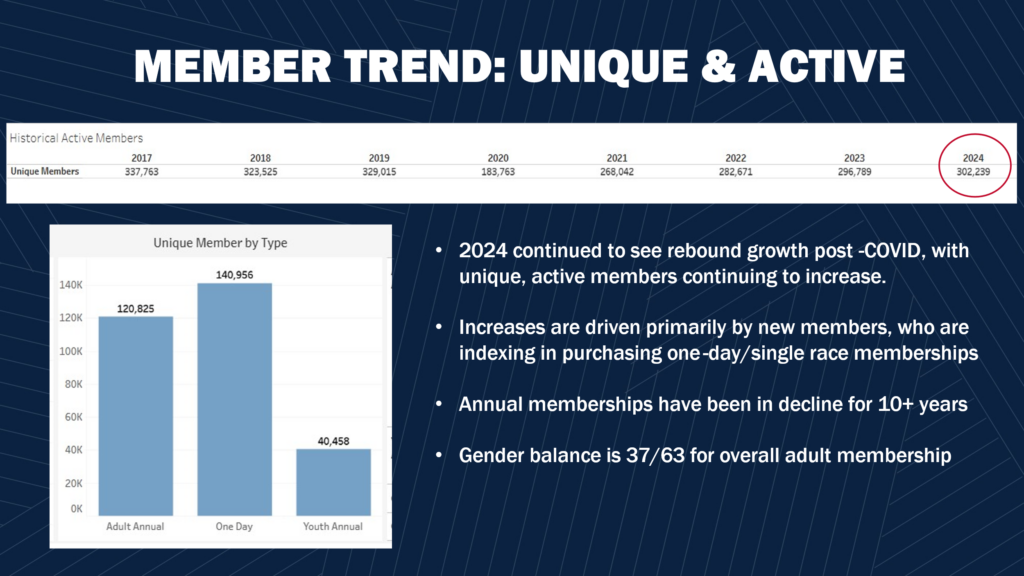
Slide Supplied by USA Triathlon
While the membership number might have gone up last year, USAT reports that overall participation was down in 2024 from 280,000 from 287,000 in 2023. Annual memberships have been declining for over 10 years, and the increase in members in 2024 “is primarily driven by new members, who are purchasing more one-day/ single-race memberships.” The most significant growth in those memberships came in the 20-29 and 30-39 age categories. The 20-29 membership increased by more than 10,000 members from 2023 to 2024, and the 30-39 membership “is now the largest cohort of members, overtaking the 40-49 age group post-COVID starting in 2022.”
The big concern for USAT is that there are fewer events for people to participate in. There were 825 sanctioned adult events in 2024 and 209 youth events. Those events included 3,600 races – as you’re used to seeing, event weekends now include a variety of different races including duathlons, swim/ bike, etc. – which was an increase over 2023 levels, according to the USAT report. The number of people at each event was up, though – “354 average participants per event and race (120 average participants per race) was the highest average recorded.”
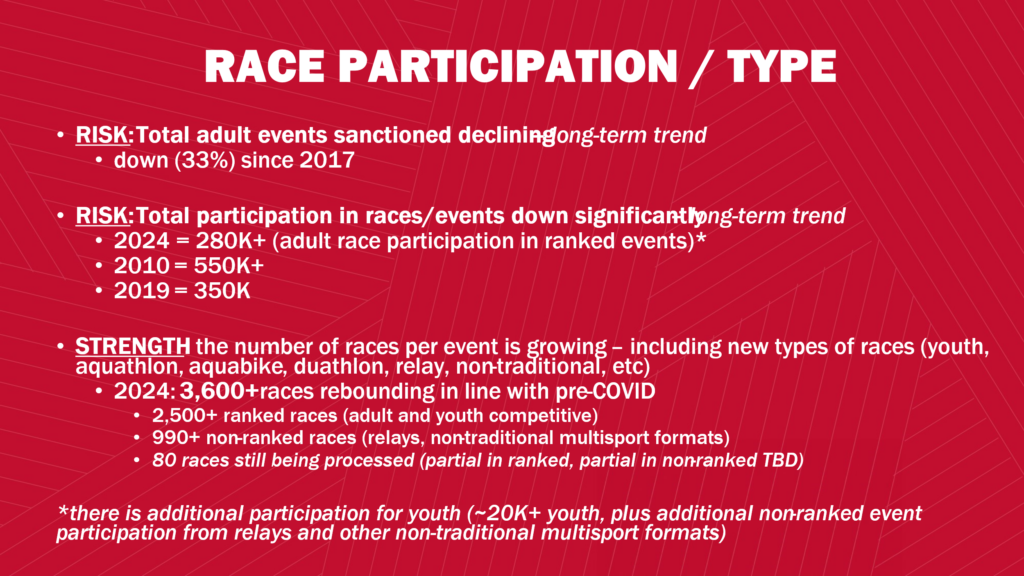
Slide Supplied by USA Triathlon
The other concern is that we’re losing race directors. That’s likely a case of many aging out of the sport, but it’s also likely a sign of how challenging it’s getting to put races on.
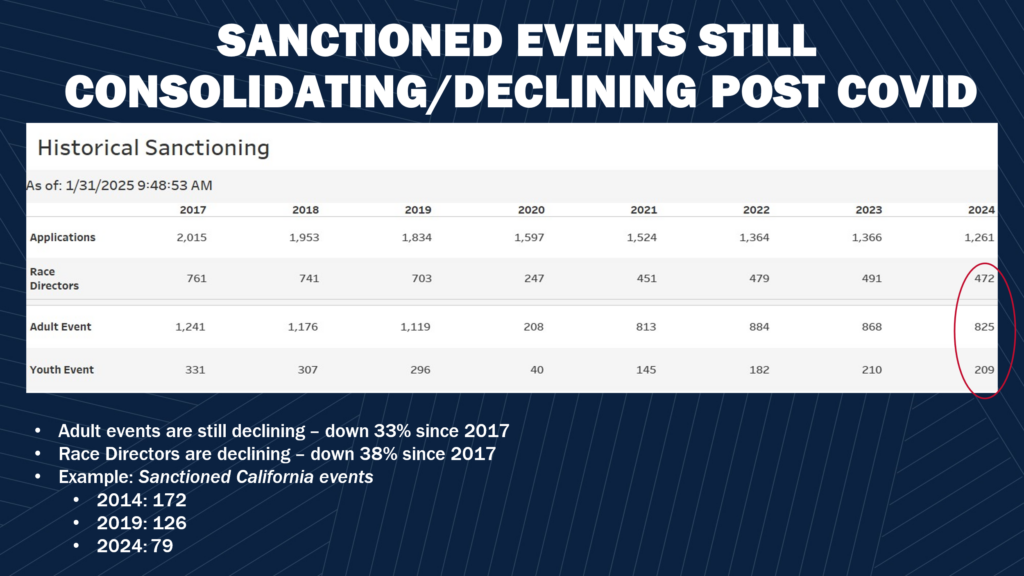
Slide Supplied by USA Triathlon
While many triathletes will happily travel for a long-distance race, beginners aren’t likely to travel very far for a sprint. The decline of events is definitely hurting the ability for people to be introduced to the sport. You can see below that there are a number of states with very few, or even no triathlon events.
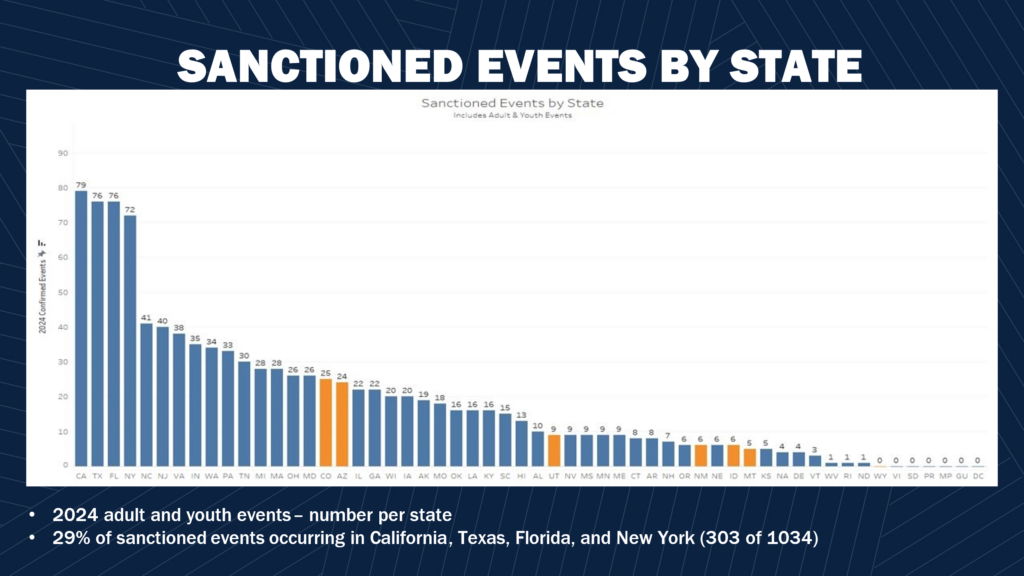
Slide Supplied by USA Triathlon
“USA Triathlon is continuing its focus on supporting adult event growth, which has been in decline since the sport peak in early 2010s,” the report continued. “The constriction and elimination of adult events is the greatest risk to the overall sport and ecosystem. Supporting race directors and events is core to the go-forward focus for USA Triathlon.”
Cal Tri’s Take
The report by Richmond and McLure suggest that there were 996 events in 2024, which was down from 2019’s 1,100 events. Comparing race participation since 2010, Richmond and McClure see a decline from the high of 546,000 finishers in 2011 to the 302,000 finishers in 2024. (Their numbers coincide with the membership number USAT cited.) Here’s a graph from their report sourced from usatriathlon.org:
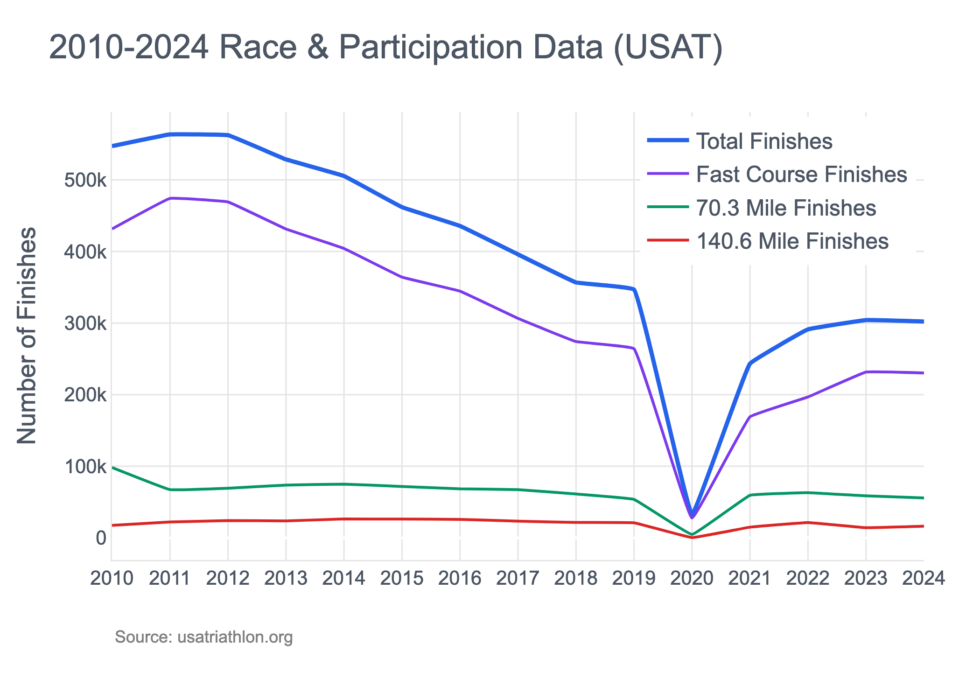
Richmond and McClure also point out that “82% of the decline was pre-pandemic, confirming that an overwhelming majority of the decline was prior to 2020. On a brighter note, the most recent year over year data – 2023-2024 – is relatively flat at about 300K finishes. Flat is the new up.”
They also point out that there’s been a 40% decline in races from 2012 (1,667) to 2024 (996). Their analysis also found that increasing the number of races at events hasn’t helped curb the decline in race finishes: “In 2024 the average number of events, e.g. triathlon, runbikerun, swimbike, at a race was 2.5 per race compared with 1.7 events per race in 2012. There were more choices, but that didn’t significantly change the trajectory of the overall finisher numbers.”
Short vs Long Distance
Richmond and McClure’s data also paint an interesting picture of distances and brand loyalty. While 76% of triathlon finishes in the US are at sprint- and Olympic-distance races, there’s been a 51.5% decline in those numbers between 2011 (474,000) and 2024 (230,000).
That trend is confirmed by USAT, which provided this chart:
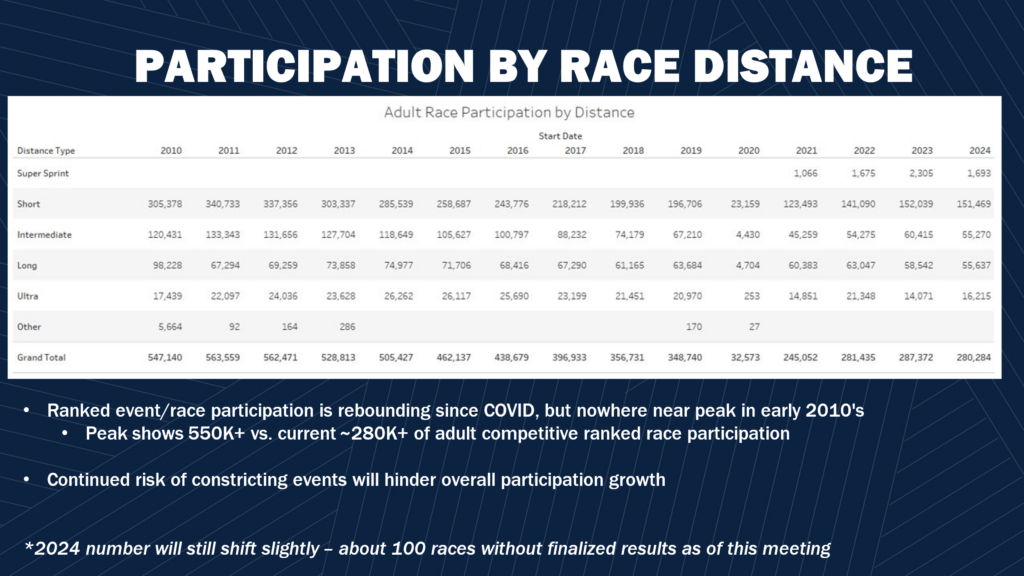
Slide Supplied by USA Triathlon
There’s been a 26% decrease in half-distance (IRONMAN 70.3-distance) finishers from 2014 (75,000) to 2024 (55,600). IRONMAN hasn’t felt that impact as much because, over that time frame, the IRONMAN 70.3 market share has increased from 56% to 86%. IRONMAN 70.3 events average 1,713 finishers. Non-IRONMAN branded events average 105.
When it comes to Ultra or IRONMAN-distance race finishes, there’s been a 38% decline in finishes between 2014 (26,000) to 2024 (16,000), Richmond and McLure found. Almost all of those finishers (99%) in 2024 competed at IRONMAN races
“Flat is the New Up”
Participation numbers have definitely bounced up since the painful COVID years, and that free-falling line on the graph has definitely “flattened.” The increase in memberships for the 20-39 demographic is also really encouraging. Hopefully we’ll also see a surge in interest for triathlon, and especially shorter races, during the lead up to the 2028 Olympic Games in Los Angeles.
Ultimately what all this shows is that the industry isn’t dialled into the numbers all that well. As Richmond and McClure point out, there’s no consistent definition of events and races, which leads to the same data coming up with different numbers. Despite all these numbers, we still don’t really have an idea of what former triathletes are doing if they’re not racing.
“Without the right information, the entire ecosystem that supports multisports, including race directors, registration companies, timing companies and brands are limited in having a consistent knowledge base,” Richmond and McClure point out.
USAT is definitely working to alleviate the information issues, and have identified the issue around the decreasing number of events in America. As mentioned earlier, we’re looking forward to seeing the organization’s strategic plan and how it looks to reverse that decline.
